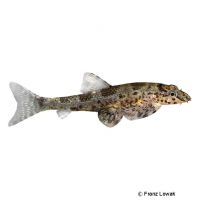Green Lizard Loach (Homalopteroides smithi)
| Green Lizard Loach Homalopteroides smithi | |
|---|---|
| Name | Green Lizard Loach |
| Name Lat. | Homalopteroides smithi |
| Synonym | Homaloptera smithi |
| Family | River Loaches |
| Family lat. | Balitoridae |
| Order | Carps |
| Order lat. | Cypriniformes |
| Origin | Thailand |
| Habitat | Streams |
| Diet | Limnivore |
| pH | 6.0-7.5 |
| Behavior | Peaceful |
| Keeping | Group |
| Care Level | Moderate |
| Reproduction | Egg scatterer |
| Breeding | None reported |
| Life Span | 5-8 years |
| Protection | No |
| Metric Units | |
| Size | 6 cm |
| Temperature | 22-24 °C |
| Hardness | 1-12 °dH |
| Aquarium | ~ 100 l |
| US Units | |
| Size | 2.4" |
| Temperature | 72-75 °F |
| Hardness | 18-214 ppm |
| Aquarium | ~ 25 gal |
Distribution and habitat
Smith's Saddleback Loaches are widely distributed from Vietnam and Cambodia to Thailand and the Malay Peninsula. They live in fast-flowing, oxygen-rich streams and small rivers, preferring shallow water, among rocks, boulders and round river pebbles covered with algae.
Maintenance
The aquarium should have robust planting, strong lighting, a substrate of sand and round-grained gravel, large rounded stones and roots (hiding places). They need soft, slightly acidic and oxygen-rich water with a strong current.
No ammonia, ammonium and nitrite should be detectable, the nitrate value should not exceed 100 mg/l. To ensure the water quality and oxygen content, a filter and heater adapted to the aquarium size is required, as well as lighting for the species-appropriate day-night rhythm of the animals.
Diet
They eat the plant cover (growth) of stones and wood and the microorganisms contained therein. In addition, the food offer consists of crushed peas, over-broken spinach and algae leaves as well as dry food with high vegetable content (e.g. kelp, spirulina), which is usually well accepted, supplemented with live food, such as cyclops, daphnia, bosmids and red mosquito larvae, which is also eaten in frozen form or a commercially available frozen special food mix
Only as much should be fed as is eaten within a few minutes. A regular and varied diet promotes health and prevents deficiency symptoms
Behaviour and compatibility
They are active, peaceful fish that live in groups. Accordingly, at least 5 Smith's Saddleback Loaches should be kept together. Socialization with other peaceful fish is possible without any problems.
Basically, only compatible fish species with similar water condition and water temperature requirements should be socialized.
Sex dimorphism
The sexes are difficult to distinguish. The females are slightly larger and appear more rounded than the males.
Reproduction and breeding
There are no known reports of successful breeding in the aquarium.
Important
They have large pectoral and pelvic fins, which are formed as adhesive organs and with which they can attach themselves to stones in the fast-flowing waters. When changing location, they swim only short distances quickly and shallowly over the bottom to immediately suck themselves back in.
The well-being of the fish should be checked regularly. The temperature should be checked daily, the pH, hardness and nitrate value at least every 14 days. A regular partial water change is recommended, even if the pollutant load has not yet reached the upper limit. Sudden changes in water quality should be avoided. Newly introduced fish must be accustomed slowly to the water in the aquarium.
Further literature can be found in your pet store.
References
Text: petdata; Image: Franz Lowak
Source: BMELV (1998): Tierschutzgutachten - Haltung von Zierfischen (Süßwasser); BAENSCH & RIEHL (2004): Aquarien Atlas Bd. 2, Mergus Verlag; ENGELMANN (2005): Zootierhaltung - Tiere in menschlicher Obhut: Fische, Verlag Harri Deutsch
- Gemäß § 21 Abs. 5 Tierschutzgesetz idgF
